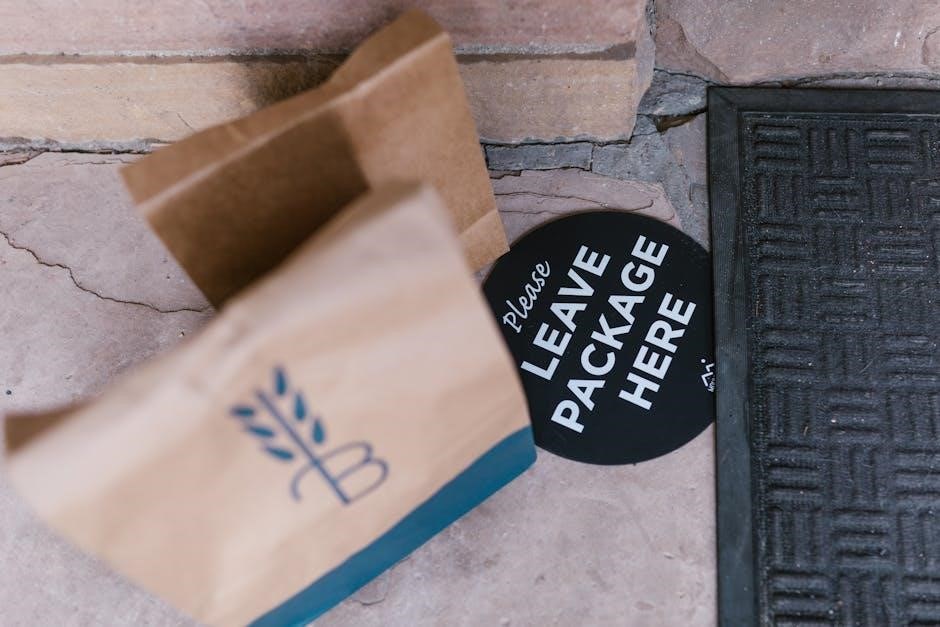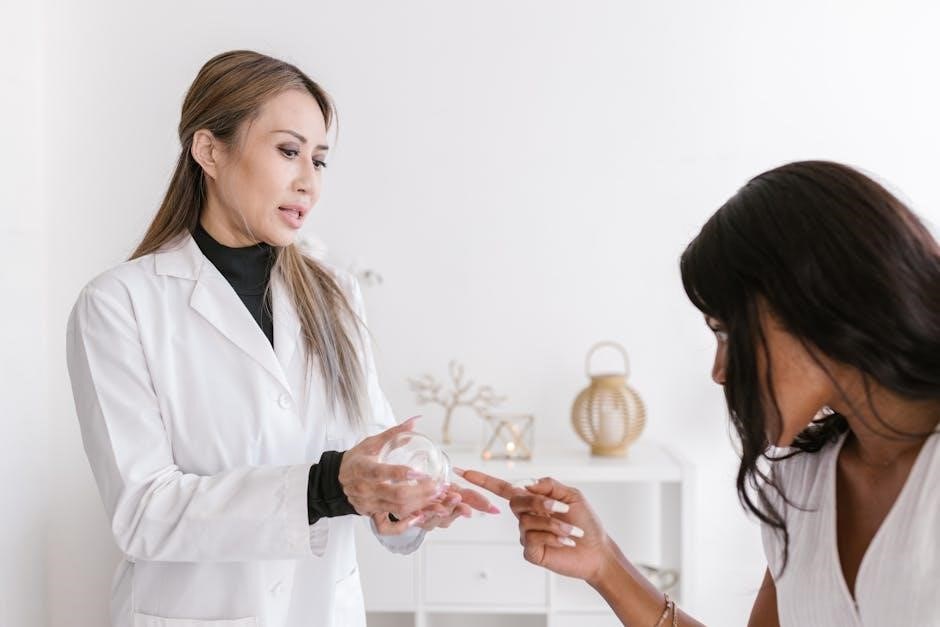EPODEX is an advanced epoxy resin designed for versatility across various surfaces. Following proper instructions ensures optimal results, durability, and a professional finish for your projects.
1.1 What is EPODEX?
EPODEX is a high-quality, versatile epoxy resin designed for a wide range of applications, from flooring and furniture restoration to artistic projects. It is known for its durability, strong adhesive properties, and ability to create smooth, professional finishes. EPODEX is suitable for both indoor and outdoor use and can be applied to various surfaces, including concrete, wood, and metal. The resin is mixed with a hardener in precise ratios, ensuring a strong and long-lasting bond. EPODEX is also environmentally friendly and breathable, making it a popular choice for upcycling and DIY projects. Its quick-drying properties and ease of use have made it a favorite among professionals and hobbyists alike. By following the instructions, users can achieve stunning results with minimal effort.
1.2 Importance of Following EPODEX Instructions
Following EPODEX instructions is crucial for achieving optimal results and ensuring safety. Proper preparation, mixing, and application techniques prevent common issues like bubbles, uneven finishes, or incomplete curing. Adhering to the guidelines ensures the epoxy resin cures correctly, providing a durable and long-lasting finish. Improper use can lead to project failure, requiring costly repairs. Additionally, following safety precautions, such as wearing protective gear and working in a well-ventilated area, minimizes health risks. By carefully following the instructions, users can unlock EPODEX’s full potential, achieving professional-looking results for their projects, whether it’s flooring, furniture, or artistic creations. Proper adherence ensures both functionality and aesthetic appeal.

Preparation Before Using EPODEX
Proper preparation is essential for a successful EPODEX application. Clean the surface thoroughly, removing dirt, oil, and moisture. Ensure it’s dry and primed if necessary. Wear protective gear and work in a well-ventilated area.
2.1 Surface Preparation for EPODEX Application
Surface preparation is critical for a successful EPODEX application. Begin by thoroughly cleaning the surface with a degreaser to remove dirt, oil, and grease. Rinse and dry completely. For best adhesion, lightly sand the surface to create a rough texture. Ensure the area is free from dust, moisture, and old adhesives or sealants. If the surface is porous or uneven, apply a primer specifically designed for epoxy applications. Allow the primer to dry fully before proceeding. A well-prepared surface ensures proper bonding, reduces the risk of peeling, and enhances the durability of the EPODEX finish. Always follow the manufacturer’s guidelines for surface preparation to achieve optimal results.
- Clean the surface with a degreaser.
- Lightly sand for better adhesion.
- Ensure the surface is dry and free from contaminants.
- Apply a primer if necessary.
2.2 Safety Precautions and Protective Gear
When working with EPODEX, prioritize safety to avoid health risks and ensure a safe application process. Always wear protective gear, including gloves, safety goggles, and a face mask to prevent skin contact and inhalation of fumes. Work in a well-ventilated area to minimize exposure to strong odors. Avoid prolonged skin contact, as it may cause irritation. Keep the workspace away from open flames or sparks, as epoxy fumes can be flammable. Use tools to handle mixed resin and hardener, and avoid ingesting or breathing in the mixture. In case of accidental spills, clean immediately with a solvent. Keep emergency contact numbers handy and follow the manufacturer’s safety guidelines for proper handling and disposal.
- Wear gloves, goggles, and a face mask.
- Work in a well-ventilated area.
- Avoid skin contact and inhalation of fumes.
- Keep away from open flames or sparks.
Mixing EPODEX Resin and Hardener
Mixing EPODEX resin and hardener requires precise ratios for optimal results. Use a digital scale to ensure accuracy, and mix thoroughly for 2-3 minutes. Avoid contamination by using clean tools. For best results, mix small batches to maintain control and prevent waste. Always follow the manufacturer’s recommended 1:1 ratio to achieve proper curing and durability.
Key Tips:
- Use a digital scale for accurate measurements.
- Mix thoroughly to avoid uneven curing.
- Follow the 1:1 ratio for resin and hardener;
3.1 Correct Mixing Ratios
Accurate mixing of EPODEX resin and hardener is essential for proper curing and durability. The recommended ratio is typically 1:1, but always verify the manufacturer’s instructions for specific products. Use a digital scale to ensure precise measurements, as incorrect ratios can lead to incomplete curing or uneven hardness. Mix the components in a clean, well-ventilated area to prevent contamination. Start with small batches to maintain control and avoid waste. For large projects, calculate the total volume needed and divide it into manageable portions. Always mix for 2-3 minutes until the mixture is uniform and free of streaks. Proper mixing ensures a strong, durable bond and a professional finish.
Key Mixing Tips:
- Use a digital scale for precise measurements.
- Follow the 1:1 ratio unless specified otherwise.
- Work in small batches for better control.
3.2 Tips for Avoiding Mixing Errors
To ensure a flawless mixing process, start by carefully measuring the resin and hardener using a digital scale. This prevents inaccuracies that can arise from manual pouring. Always mix in a clean, dry environment to avoid contamination from dust or moisture. Use a high-quality mixing stick or drill with a paddle attachment to blend thoroughly, scraping the sides and bottom of the mixing container to incorporate all components evenly. Avoid overheating the mixture, as this can accelerate curing and lead to bubbles or uneven consistency. Work in a well-ventilated area to prevent inhaling fumes. Finally, follow the manufacturer’s instructions precisely, as deviations can compromise the final result. Proper preparation and attention to detail are key to achieving a smooth, error-free application.
Key Tips:
- Use a digital scale for precise measurements.
- Mix in a clean, dry environment to prevent contamination.
- Scrape the mixing container thoroughly during blending.
- Avoid overheating the mixture to prevent curing issues.
Application of EPODEX
EPODEX application involves spreading evenly across prepared surfaces, ensuring smooth finishes; Techniques vary by surface type for optimal adhesion and desired aesthetic results.
4.1 Applying EPODEX to Different Surfaces
EPODEX can be applied to various surfaces, including metal, wood, concrete, glass, and plastic. For metal surfaces, ensure they are clean and free of rust for proper adhesion. Wood surfaces should be sanded to create a rough texture, enhancing the bond. Concrete requires a thorough cleaning and drying process before application. Glass and plastic surfaces need to be lightly sanded to ensure a strong bond. Always follow the recommended layering thickness to avoid uneven curing. For floors, use a notched trowel or squeegee for even spreading, while brushes or rollers work best for smaller, detailed areas. Allow each layer to cure slightly before adding additional coats for a seamless finish.
4.2 Techniques for Smooth and Even Spreading
For smooth and even spreading of EPODEX, use a notched trowel or squeegee to apply thin, uniform layers. Work in small, manageable sections to maintain control and avoid pooling. Use a roller to spread the epoxy evenly, ensuring full coverage without over-application. For detailed areas, a brush can be used to feather out edges and blend seamlessly. Maintain a consistent spreading pattern to prevent unevenness. If bubbles form, gently pass a heat gun or hair dryer over the surface to eliminate them without overheating the epoxy.
Allow each layer to cure slightly before adding the next to prevent sagging or unevenness. Use a spirit level to ensure surfaces are even, and apply steady, firm pressure to achieve a professional finish.

Curing and Drying Times
EPODEX typically cures within 24 hours at room temperature. Factors like humidity and temperature can affect curing time, so follow instructions for optimal results.
5.1 Recommended Curing Time for EPODEX
The recommended curing time for EPODEX epoxy resin is typically 24 hours at room temperature (around 20-25°C or 68-77°F). However, this duration can vary depending on environmental conditions such as humidity and temperature. For optimal results, ensure the surface is clean and dry before application. It is crucial to avoid handling or applying additional coatings until the epoxy has fully cured. In cooler temperatures, curing may take longer, while warmer conditions can accelerate the process. Always refer to the manufacturer’s instructions for specific guidelines tailored to your project. Proper curing ensures a durable and professional finish, so patience is key. After curing, the surface can be sanded for a smooth finish if desired.
5.2 Factors Affecting Curing Time and Temperature
Several factors influence the curing time and temperature of EPODEX epoxy resin. Temperature plays a significant role, with higher temperatures accelerating the curing process and lower temperatures slowing it down. Ideal curing occurs at room temperature (20-25°C or 68-77°F). Humidity also affects curing, as high moisture levels can hinder the process. Additionally, the thickness of the epoxy layer impacts curing time—thicker layers take longer to cure fully. Proper ventilation is essential to avoid the buildup of fumes, which can slow curing. It is crucial to follow the manufacturer’s guidelines for temperature and environmental conditions to ensure proper curing. Avoid using heat guns or direct heat sources to speed up the process, as this can lead to uneven curing or bubbles. Always monitor the environment to achieve the best results with EPODEX.
Safety and Handling
Always wear protective gear, including gloves and goggles, when handling EPODEX. Work in a well-ventilated area to avoid inhaling fumes. Avoid skin contact and follow all safety precautions to ensure a safe working environment.
6.1 Proper Handling of EPODEX Materials
Proper handling of EPODEX materials is essential for safety and effectiveness. Always wear protective gloves, goggles, and a mask to prevent skin contact and inhalation of fumes. Work in a well-ventilated area, away from open flames or sparks. Ensure surfaces are clean and dry before application. Store EPODEX components in their original containers, keeping them away from children and pets. Avoid mixing or heating the resin and hardener without proper ventilation. Follow the manufacturer’s guidelines for handling and disposal. In case of spills, clean immediately with a recommended solvent. Keep emergency contact information handy. Proper handling ensures a safe and successful application process.
6.2 Disposal of Leftover EPODEX
Disposing of leftover EPODEX materials requires careful attention to environmental and safety guidelines. Always follow the manufacturer’s instructions for proper disposal methods. Check local regulations regarding hazardous waste, as EPODEX may fall under this category. If the product is still usable, consider storing it for future projects in its original container. For non-usable leftovers, neutralize the material if possible, and dispose of it at designated hazardous waste collection facilities. Ensure containers are properly sealed and handled safely. Avoid pouring EPODEX down drains or mixing it with regular waste. Utilize community resources or recycling centers that accept chemical waste. Proper disposal helps protect the environment and adheres to safety standards.

Advanced Techniques with EPODEX
Explore advanced techniques with EPODEX, including creating vibrant color effects, embedding materials, and achieving a professional finish. Experiment with layering and sanding for unique results.
7.1 Creating Color Effects with EPODEX
Creating color effects with EPODEX is a great way to enhance your projects. Start by adding pigments or dyes to the resin before mixing. Alcohol inks and powders work exceptionally well, offering vibrant hues. For layered effects, pour different colors sequentially, allowing each layer to partially cure. Glow-in-the-dark powders can also be incorporated for a unique finish; Experiment with metallic or iridescent additives for a professional look. Always ensure proper mixing to avoid uneven color distribution. Follow the manufacturer’s guidelines for ratios to maintain resin integrity. With practice, you can achieve stunning, intricate designs that elevate your work. Don’t forget to test colors on small samples first to preview the final result.
7.2 Adding Inclusions and Embedments
Adding inclusions and embedments to EPODEX resin can enhance creativity and personalize your projects. Materials like glitter, beads, or small objects can be embedded for unique effects. Ensure items are dry and clean before adding. Mix resin and hardener first, then gently fold in inclusions to avoid air bubbles. For deeper embedments, pour a thin layer, place the item, and fill to the top. Larger objects may require securing with a dab of resin to prevent sinking. Experiment with different materials and techniques to create intricate designs. Proper sealing and finishing ensure durability. Always follow safety guidelines and test techniques on small samples first for best results.
Troubleshooting Common Issues
Common issues like bubbles or uneven surfaces can be resolved with heat guns or needles. Ensure proper mixing ratios and curing times to avoid incomplete hardening.
8.1 Dealing with Bubbles and Air Pockets
Bubbles and air pockets are common issues when working with EPODEX. To address this, gently use a heat gun or a needle to pop bubbles before the resin hardens. Ensure the surface is leveled and free from dust or debris. Mixing the resin and hardener thoroughly but carefully can prevent air pockets from forming. If bubbles appear after pouring, lightly torch the area or use a toothpick to remove them. Avoid over-mixing, as it introduces air. For deep pours, pour in layers, allowing each layer to set slightly before adding the next. Proper temperature control also helps minimize bubble formation. Always work in a well-ventilated, dust-free environment to achieve a smooth finish.
8.2 Fixing Uneven or Incomplete Curing
If EPODEX cures unevenly or incompletely, it may be due to incorrect mixing ratios, insufficient curing time, or low temperatures. To fix this, allow the resin to cure for the recommended time. If still soft, wait longer or apply heat with a heat gun (avoid overheating). For minor unevenness, sand the surface lightly and apply a thin additional coat. Ensure the environment is warm and dry, as cold or humid conditions slow curing. Avoid rushing the process, as this can lead to incomplete curing; For severe issues, consult the manufacturer’s guide or contact support for assistance. Properly following instructions and maintaining ideal conditions are key to achieving a smooth, even finish.

Frequently Asked Questions (FAQs)
EPODEX instructions are designed to ensure safety and optimal results. Common questions include proper mixing ratios, curing times, and surface compatibility. Always refer to the manual for specific guidance.
9.1 What if I Accidentally Mix Too Much EPODEX?
If you accidentally mix too much EPODEX, remain calm and assess the situation. Always wear protective gear, including gloves and goggles, to avoid skin or eye irritation. If the mixture is still usable, consider applying it to multiple projects or letting it sit for a few hours to thicken before pouring. Ensure the workspace is well-ventilated to prevent inhaling fumes. If the epoxy begins to cure prematurely, it may not be suitable for your intended use. Properly dispose of any leftover material according to the manufacturer’s guidelines. For best results, always follow the recommended mixing ratios and curing times provided in the EPODEX instructions.
9.2 Can EPODEX Be Used on All Types of Surfaces?
EPODEX is highly versatile and can be applied to a variety of surfaces, including wood, metal, concrete, and even some plastics. However, it is not suitable for all surfaces without proper preparation. For instance, surfaces like plastic or unprepared wood may require special primers or treatments to ensure proper adhesion. Always clean and dry the surface thoroughly before application. For best results, lightly grind or sand the surface to create a better bond. Avoid applying EPODEX to surfaces that are exposed to direct water, high temperatures, or heavy wear without additional protective coatings. Refer to the manufacturer’s guidelines for specific surface recommendations and ensure compatibility before use.
Following EPODEX instructions ensures professional results. Always prepare surfaces, mix correctly, and allow proper curing times. Experiment with techniques and practice for mastery. Happy creating!
10.1 Summary of Key EPODEX Instructions
Always follow EPODEX instructions carefully for optimal results. Ensure proper surface preparation, including cleaning and priming, to guarantee strong adhesion. Mix resin and hardener in the correct ratios, and stir thoroughly to avoid errors. Apply the mixture evenly, using techniques like spreading or pouring, depending on the project. Allow the recommended curing time, considering temperature and environmental factors. Wear safety gear, such as gloves and goggles, to protect yourself. For best results, avoid rushing the process and ensure good ventilation. If issues arise, refer to troubleshooting tips for solutions. Practice makes perfect, so experiment with small projects to refine your skills. By adhering to these guidelines, you can achieve professional-looking finishes and durable results with EPODEX.
10.2 Encouragement to Practice and Experiment
Practicing with EPODEX is key to mastering its application and achieving desired results. Start with small, simple projects to build confidence and skill. Experiment with different techniques, such as color effects or adding inclusions, to explore EPODEX’s creative potential. Don’t be discouraged by initial mistakes—they are opportunities to learn and improve. As you gain experience, you’ll uncover new ways to use EPODEX for unique and personalized finishes. Remember, creativity thrives when you push boundaries and try new approaches. With patience and practice, you’ll unlock the full versatility of EPODEX and create stunning, professional-quality outcomes for your projects.
